Reading time for children: 8 min
There was once a man who had seven sons, and still he had no daughter, however much he wished for one. At length his wife again gave him hope of a child, and when it came into the world it was a girl. The joy was great, but the child was sickly and small, and had to be privately baptized on account of its weakness. The father sent one of the boys in haste to the spring to fetch water for the baptism.
The other six went with him, and as each of them wanted to be first to fill it, the jug fell into the well. There they stood and did not know what to do, and none of them dared to go home. As they still did not return, the father grew impatient, and said, „They have certainly forgotten it for some game, the wicked boys!“ He became afraid that the girl would have to die without being baptized, and in his anger cried, „I wish the boys were all turned into ravens.“
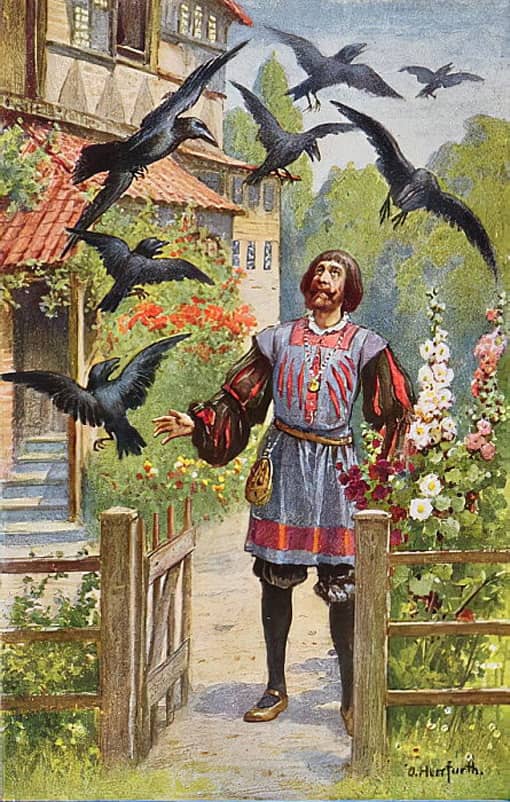 Image: Oskar Herrfurth (1862-1934)
Image: Oskar Herrfurth (1862-1934)Hardly was the word spoken before he heard a whirring of wings over his head in the air, looked up and saw seven coal-black ravens flying away. The parents could not recall the curse, and however sad they were at the loss of their seven sons, they still to some extent comforted themselves with their dear little daughter, who soon grew strong and every day became more beautiful.
For a long time she did not know that she had had brothers, for her parents were careful not to mention them before her, but one day she accidentally heard some people saying of herself, „that the girl was certainly beautiful, but that in reality she was to blame for the misfortune which had befallen her seven brothers.“ Then she was much troubled, and went to her father and mother and asked if it was true that she had had brothers, and what had become of them?
The parents now dared keep the secret no longer, but said that what had befallen her brothers was the will of Heaven, and that her birth had only been the innocent cause. But the maiden took it to heart daily, and thought she must deliver her brothers. She had no rest or peace until she set out secretly, and went forth into the wide world to trace out her brothers and set them free, let it cost what it might. She took nothing with her but a little ring belonging to her parents as a keepsake, a loaf of bread against hunger, a little pitcher of water against thirst, and a little chair as a provision against weariness.
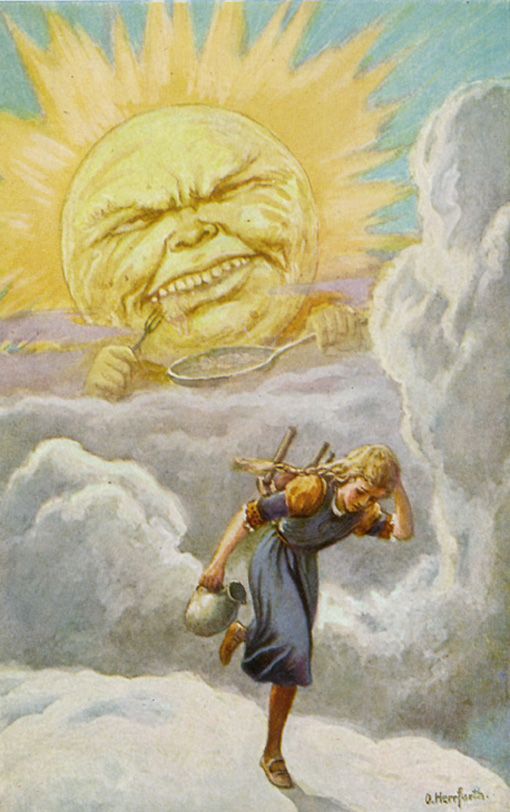 Image: Oskar Herrfurth (1862-1934)
Image: Oskar Herrfurth (1862-1934)And now she went continually onwards, far, far to the very end of the world. Then she came to the sun, but it was too hot and terrible, and devoured little children.
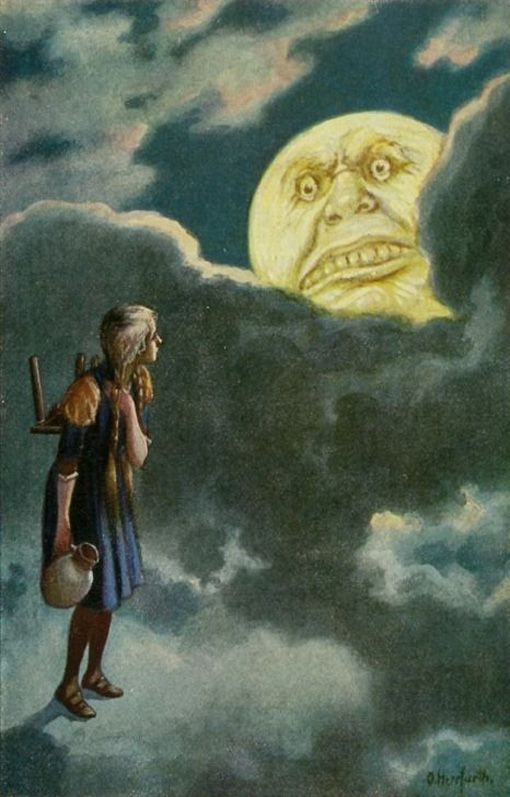 Image: Oskar Herrfurth (1862-1934)
Image: Oskar Herrfurth (1862-1934)Hastily she ran away, and ran to the moon, but it was far too cold, and also awful and malicious, and when it saw the child, it said, „I smell, I smell the flesh of men.“ On this she ran swiftly away, and came to the stars, which were kind and good to her, and each of them sat on its own particular little chair.
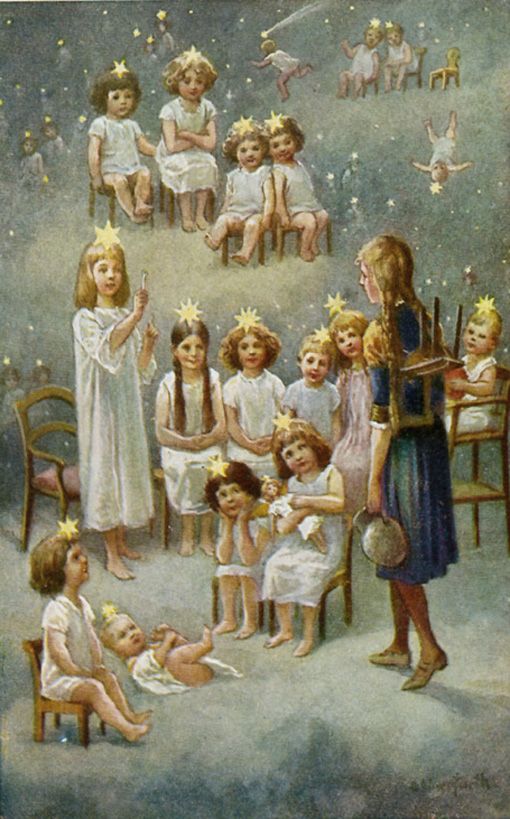 Image: Oskar Herrfurth (1862-1934)
Image: Oskar Herrfurth (1862-1934)But the morning star arose, and gave her the drumstick of a chicken, and said, „If you thou hast not that drumstick thou canst not open the Glass mountain, and in the Glass mountain are thy brothers.“
The maiden took the drumstick, wrapped it carefully in a cloth, and went onwards again until she came to the Glass mountain. The door was shut, and she thought she would take out the drumstick; but when she undid the cloth, it was empty, and she had lost the good star’s present. What was she now to do?
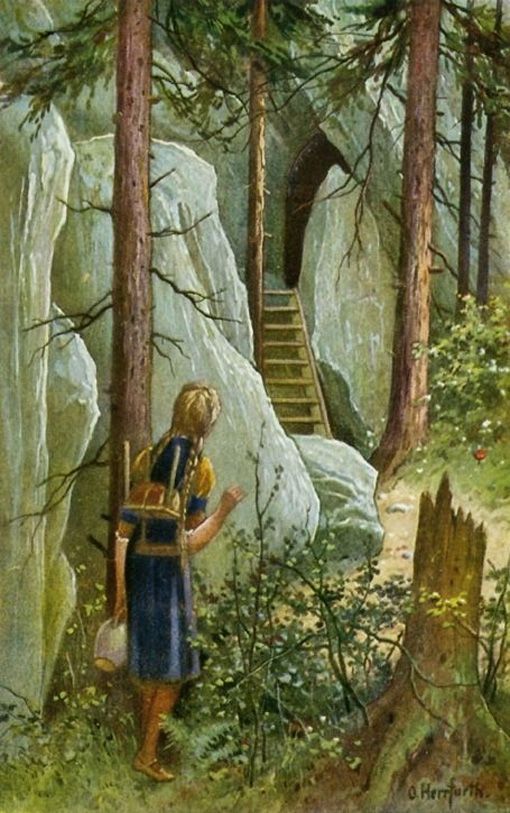 Image: Oskar Herrfurth (1862-1934)
Image: Oskar Herrfurth (1862-1934)She wished to rescue her brothers, and had no key to the Glass mountain. The good sister took a knife, cut off one of her little fingers, put it in the door, and succeeded in opening it. When she had gone inside, a little dwarf came to meet her, who said, „My child, what are you looking for?“ – „I am looking for my brothers, the seven ravens,“ she replied. The dwarf said, „The lord ravens are not at home, but if you will wait here until they come, step in.“ Thereupon the little dwarf carried the ravens‘ dinner in, on seven little plates, and in seven little glasses, and the little sister ate a morsel from each plate, and from each little glass she took a sip, but in the last little glass she dropped the ring which she had brought away with her.
Suddenly she heard a whirring of wings and a rushing through the air, and then the little dwarf said, „Now the lord ravens are flying home.“ Then they came, and wanted to eat and drink, and looked for their little plates and glasses. Then said one after the other, „Who has eaten something from my plate? Who has drunk out of my little glass? It was a human mouth.“ And when the seventh came to the bottom of the glass, the ring rolled against his mouth.
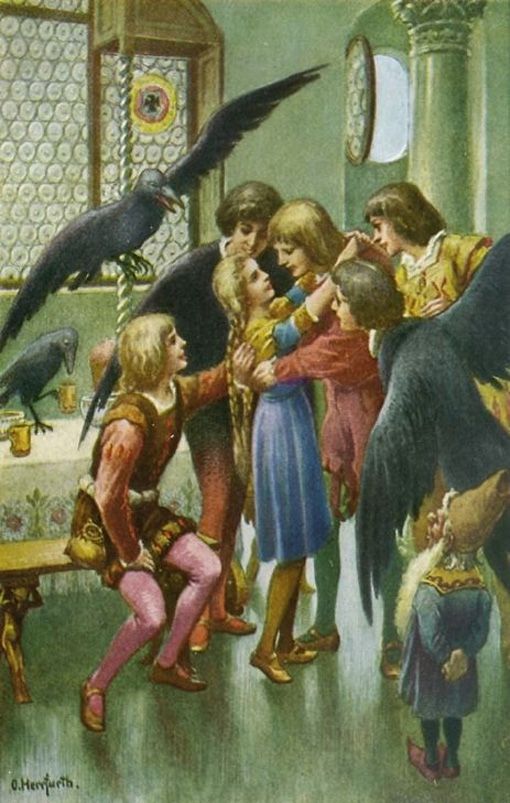 Image: Oskar Herrfurth (1862-1934)
Image: Oskar Herrfurth (1862-1934)Then he looked at it, and saw that it was a ring belonging to his father and mother, and said, „God grant that our sister may be here, and then we shall be free.“ When the maiden, who was standing behind the door watching, heard that wish, she came forth, and on this all the ravens were restored to their human form again. And they embraced and kissed each other, and went joyfully home.
 Learn languages. Double-tap on a word.Learn languages in context with Childstories.org and Deepl.com.
Learn languages. Double-tap on a word.Learn languages in context with Childstories.org and Deepl.com.Backgrounds to fairy tale „The Seven Ravens“
„The Seven Ravens“ is a fairy tale collected by the Brothers Grimm and included in their compilation „Grimm’s Fairy Tales“ (originally titled „Children’s and Household Tales“ or „Kinder- und Hausmärchen“ in German), first published in 1812. This tale is classified as ATU 451 (The Brothers Who Were Turned into Birds) in the Aarne-Thompson-Uther classification system, which categorizes folktales based on their narrative structure and elements.
The story likely has roots in European oral storytelling traditions and shares similarities with other tales of transformation and quests to break curses or spells. As with many other stories collected by the Brothers Grimm, „The Seven Ravens“ has been passed down through generations and adapted in various forms. The Brothers Grimm, Jacob and Wilhelm, were German academics and cultural researchers who sought to preserve the cultural heritage and oral storytelling traditions of German-speaking regions. They collected and published numerous folk and fairy tales during the 19th century, with many of these tales reflecting the values, beliefs, and societal norms of the time.
In „The Seven Ravens,“ a man and his wife have seven sons but long for a daughter. When their wish is finally granted, and a daughter is born, she is weak and frail. The father sends his seven sons to fetch water from a well to baptize her, hoping to strengthen her. The brothers accidentally drop the jug in the well, and fearing their father’s anger, they hesitate to return home. The father, growing impatient and angry, mistakenly curses his sons, wishing them to be turned into ravens. The curse comes true, and the brothers are transformed into ravens, flying away from their home. The young sister, who is unaware of her brothers‘ fate, eventually sets out on a quest to find them and break the curse, leading her to face various trials and challenges.
The Brothers Grimm were academics, linguists, and cultural researchers in the 19th century, and they had a keen interest in folklore and stories. They collected and published these fairy tales as part of a broader effort to preserve the rich oral storytelling traditions of German-speaking regions, which they feared might be lost due to the process of modernization and industrialization. The fairy tales they collected came from various sources, including peasants, friends, and family members, as well as existing literary works. Some of the stories were also influenced by earlier international folklore collections. As a result, the Brothers Grimm’s collection became a groundbreaking work that helped establish the study of folklore as a significant academic discipline.
The Grimm brothers revised and expanded their collection over the years, with the final edition being published in 1857. This final edition contained over 200 stories. Their fairy tales have since become an essential part of Western popular culture and have been translated into numerous languages, adapted into films, television shows, and stage productions, and have inspired countless works of literature. „The Seven Ravens“ is one of the lesser-known stories in the Grimm brothers‘ collection. Still, it has been adapted in various forms, including animated films and even as an opera by German composer Wilfried Hiller. Like other Grimm fairy tales, „The Seven Ravens“ shares certain elements with similar stories in other cultures, highlighting the universality of certain themes and narrative structures in folklore.
„The Seven Ravens“ explores themes of transformation, love, loyalty, determination, and the power of words. It emphasizes the importance of family bonds and the lengths one is willing to go to save their loved ones from a terrible fate.
Interpretations to fairy tale „The Seven Ravens“
„The Seven Ravens“ has been subject to various interpretations, highlighting the richness and depth of the Brothers Grimm’s fairy tales. Some key interpretations of the story include:
Family bonds and loyalty: The story explores the strength of familial love and loyalty, with the sister embarking on a quest to find her brothers and break the curse that binds them. Her determination to save her brothers showcases the deep connection between siblings and the lengths one might go to protect their loved ones. One of the central themes in the story is the bond between siblings. Despite the girl’s initial unawareness of her brothers, she is determined to save them when she learns of their plight. The siblings‘ love and loyalty to one another are essential to their eventual reunion and transformation.
Resilience and determination: The sister’s journey to find her brothers is filled with challenges and obstacles. Her perseverance and unwavering commitment to her quest demonstrate the importance of resilience and determination in the face of adversity.
Transformation and redemption: The transformation of the brothers into ravens serves as a metaphor for change, growth, and personal development. The sister’s quest to find her brothers and break the curse highlights the potential for redemption and the power of love to bring about positive change. The tale also carries a message of forgiveness, as the sister does not blame her brothers or hold a grudge against her father for their transformation. Instead, she seeks to save them and restore their humanity, suggesting that redemption is possible when there is genuine love and understanding.
The role of women in society: In the context of the 19th-century society in which the Brothers Grimm lived, the sister’s courage and independence can be seen as a subversion of traditional gender roles. Despite her initially frail state, the sister embarks on a heroic quest, demonstrating that women can be strong, resourceful, and capable of overcoming challenges.
Consequences of Words and Actions: The father’s impulsive wish to turn his sons into ravens demonstrates the potential consequences of speaking or acting in anger. It serves as a reminder to be cautious and thoughtful when expressing emotions, as hasty decisions can have long-lasting repercussions. The tale demonstrates how words, even spoken in anger or frustration, can have significant consequences. The father’s impulsive curse leads to the transformation of his sons into ravens, emphasizing the importance of being mindful of what we say and the impact it may have on others.
Perseverance and Sacrifice: The sister’s journey to find her brothers is filled with trials and obstacles, but she remains steadfast in her mission. Her willingness to make personal sacrifices (such as cutting off her finger) showcases her dedication and love for her family, emphasizing the importance of determination and selflessness in overcoming challenges.
The Power of Kindness: The kindness of the stars, particularly the morning star, contrasts with the sun and moon’s harshness. This contrast highlights the importance of kindness and assistance in achieving one’s goals. Additionally, the story underscores the impact of a small act of kindness, as the morning star’s gift ultimately helps the sister succeed in her quest.
These interpretations of „The Seven Ravens“ showcase the depth and complexity of the story, revealing themes of family, loyalty, determination, and the power of words that continue to resonate with readers today. Overall, „The Seven Ravens“ is a multi-faceted story that explores the themes of family bonds, perseverance, sacrifice, forgiveness, redemption, and the power of kindness.
Adaptions of the fairy tale „The Seven Ravens“
„The Seven Ravens“ is a German fairy tale collected by the Brothers Grimm, who were Jacob (1785–1863) and Wilhelm Grimm (1786–1859). The tale is included in their renowned collection, „Grimm’s Fairy Tales“ (also known as „Children’s and Household Tales“ or „Kinder- und Hausmärchen“ in German), which was first published in 1812. „The Seven Ravens“ has been adapted and reimagined in various forms over the years, demonstrating the adaptability and enduring appeal of the Brothers Grimm’s fairy tales. Some specific examples of these adaptations include:
Literature: „The Thirteenth Fairy“ by Jane Yolen: This novel incorporates elements of „The Seven Ravens“ into a larger narrative that weaves together various fairy tales, exploring themes of transformation, family, and destiny. The novel „The Raven Boys“ by Maggie Stiefvater: This young adult novel, published in 2012, features a group of boys searching for a Welsh king who they believe was transformed into a raven. The story is not a direct adaptation of „The Seven Ravens,“ but it incorporates themes of transformation and the power of nature.
Films: „The Seven Ravens“ (1937): A Czechoslovakian film directed by Martin Frič is an early adaptation of the Grimm’s fairy tale, bringing the story to life on the big screen. The film „Brothers Grimm“ (2005): Although not a direct adaptation of „The Seven Ravens,“ this film directed by Terry Gilliam incorporates elements of the fairy tale, as well as other Grimm stories. The film features Matt Damon and Heath Ledger as the Brothers Grimm.
Television: „SimsalaGrimm“ (1999-2010): This animated German television series retells various Grimm fairy tales, including „The Seven Ravens,“ in a lighthearted and engaging way for children. The TV movie „The Seven Ravens“ (1979): This adaptation, directed by Siegfried Hartmann, features live-action actors and was produced for German television. It stays true to the original story while adding some dramatic elements.
Animation: „The Seven Ravens“ (2015): A Russian animated short film directed by Anastasia Melikhova offers a visually striking adaptation of the Grimm’s fairy tale, using colorful and imaginative animation to tell the story. The animated short film „The Seven Ravens“ (1937): This adaptation by Lotte Reiniger was one of the earliest animated versions of the tale. It uses Reiniger’s signature silhouette animation style to bring the story to life.
Theater and ballet: „The Seven Ravens“ Ballet: Choreographed by Jiří Bubeníček, this ballet adaptation of the Grimm’s fairy tale premiered in 2015 at the Semperoper Ballet in Dresden, Germany. The ballet combines classical and contemporary elements to create a captivating retelling of the story.
Picture books: „The Seven Ravens“ by Lisbeth Zwerger: This illustrated edition of the Grimm’s fairy tale features beautiful artwork that brings the story to life for young readers. The children’s book „The Seven Ravens“ by Jacob Grimm and Wilhelm Grimm: This illustrated version of the tale, published by North-South Books in 1984, features illustrations by Bernadette Watts and includes a brief history of the Brothers Grimm.
„The Seven Ravens“ has been adapted into various forms of media, including films, TV shows, and books. These adaptations showcase the enduring appeal and versatility of „The Seven Ravens.“ The story has been reimagined in various genres, formats, and styles, illustrating the universality and adaptability of the Brothers Grimm’s classic fairy tales.
These are just a few examples of the many adaptations of „The Seven Ravens“ that have been created over the years.
Summary of the plot
„The Seven Ravens“ is a fairy tale collected by the Brothers Grimm, telling the story of a girl’s quest to rescue her seven brothers who have been turned into ravens. The plot begins with a man and his wife who have seven sons but long for a daughter. When the daughter is finally born, she is weak and frail, prompting the father to send his sons to fetch water for her baptism.
The brothers, in their haste, accidentally drop the jug into the well and are afraid to return home without it. Meanwhile, the father grows impatient and angry, mistakenly cursing his sons by wishing them to be turned into ravens. The curse comes true, and the brothers are transformed and fly away.
Years later, when the sister learns about her brothers‘ fate, she sets out on a journey to find them and break the curse. Along the way, she faces numerous trials and challenges. She eventually reaches the Glass Mountain, where the ravens reside, but she is unable to climb it. She prays for help, and an angel appears, providing her with a stairway to the top.
Upon reaching her brothers, she uses a magical item (a ring, bone, or star, depending on the version) to break the curse, transforming them back into humans. The siblings are reunited, and they return home to live happily ever after.
„The Seven Ravens“ explores themes of family bonds, loyalty, determination, and the power of words. The story emphasizes the importance of love and perseverance in the face of adversity, as well as the consequences of speaking in anger.
Abstract
„The Seven Ravens“ is a fairy tale by Brothers Grimm about a man and his wife who have seven sons but long for a daughter. When they finally have a baby girl, she is weak and needs to be baptized immediately. The father sends his seven sons to fetch water, but they accidentally drop the jug in the well and don’t return home. In his impatience, the father wishes that his sons were turned into ravens, and his wish is granted.
The daughter, unaware of her brothers, overhears people blaming her for their fate. Determined to free her brothers, she sets out on a journey with a ring, bread, water, and a chair as provisions. She encounters the sun, which is too hot and dangerous, the moon, which is cold and malicious, and finally, the stars, who are kind to her. The morning star gives her a chicken drumstick to open the Glass Mountain, where her brothers are trapped.
Unfortunately, she loses the drumstick and must use her finger as a key to open the Glass Mountain. Inside, she meets a dwarf who informs her that her brothers are not home. She waits and eats from their plates, sipping from their glasses, and drops the ring in the last glass. When the brothers return as ravens, they find their plates and glasses disturbed and the ring in the last glass. One brother wishes for their sister to appear, and she does, turning them back into humans. They joyfully reunite and return home together.
Informations for scientific analysis
Fairy tale statistics | Value |
|---|---|
| Number | KHM 25 |
| Aarne-Thompson-Uther-Index | ATU Typ 451 |
| Translations | DE, EN, DA, ES, FR, PT, FI, HU, IT, JA, NL, PL, RO, RU, TR, VI, ZH |
| Readability Index by Björnsson | 35.2 |
| Flesch-Reading-Ease Index | 75.6 |
| Flesch–Kincaid Grade-Level | 8.7 |
| Gunning Fog Index | 11.2 |
| Coleman–Liau Index | 8 |
| SMOG Index | 8.8 |
| Automated Readability Index | 9.8 |
| Character Count | 4.960 |
| Letter Count | 3.827 |
| Sentence Count | 39 |
| Word Count | 945 |
| Average Words per Sentence | 24,23 |
| Words with more than 6 letters | 104 |
| Percentage of long words | 11% |
| Number of Syllables | 1.191 |
| Average Syllables per Word | 1,26 |
| Words with three Syllables | 36 |
| Percentage Words with three Syllables | 3.8% |
















